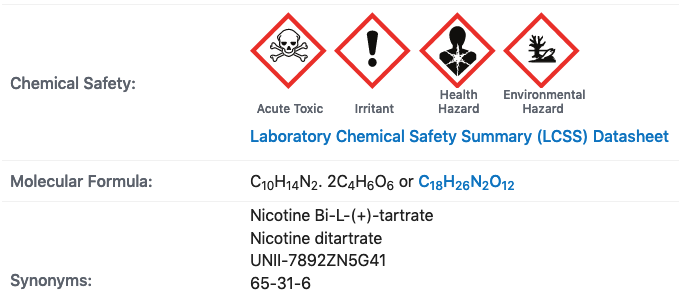Chemical Inventory and GHS Pictograms
When developing the chemical inventory system in Lab Spend, we wanted to included GHS Pictograms. Uniquely, we allow GHS pictograms to be displayed next to each item to reduce the friction in finding looking them up in the safety data sheet (SDS).

Lab Spend allows users to look up the GHS Pictograms, enter them and then they can be viewed by everyone in the lab. When possible, we’re also making this task faster by autocompleting the GHS selections. In developing the software to automate this process, we’ve come across a number of interesting situations.
For example, let’s say a lab is buying a chemical from two different vendors, will the GHS pictograms be the same?
The answer is No. We see variations for the same chemical such as (-)-Nicotine Tartrate, CAS number 65-31-6 that is sold by both MilliporeSigma (Sigma-Aldrich), catalog number 1463304 and ThermoFisher Scientific under catalog number BP2533. Below is an image of the SDS, Version 5.0 from MilliporeSigma

Here is also Section 2 from the SDS, Version 4, but this time ThermoFisher:

As you may have already noticed, MilliporeSigma includes both the Acute Toxicity and Health Hazard while ThermoFisher has only the Acute Toxicity pictogram. We also looked at the percent of the product which may account for the difference, MilliporeSigma gives a range of 90-100% and ThermoFisher states >95% therefore these products can overlap in contents. If you search the NIH website by CAS 65-31-6 which is this chemical it returns four different pictograms:

Again it appears there are differences in pictograms for the same product. This isn’t an isolated case such as MilliporeSigma item 4-Hexylresorcinol, CAS Number: 136-77-6, section 2.2:

ThermoFisher offers this item with a different name, 4-n-Hexylresorcinol, but has the same CAS number.

As you can see MilliporeSigma has an Aquatic Toxicity pictogram while ThermoFisher only has the Warning pictogram. Lastly, item 2-Ethyl-2-oxazoline by MilliporeSigma has two pictograms while ThermoFisher has three.

ThermoFisher:

In this case, MilliporeSigma is missing the Corrosive pictogram.
Are pictograms optional?
Another issue you may not be aware of, is some GHS pictograms are optional in that the manufacturer has a choice of which pictogram to include. For example, Fisher Scientific sells 1,1-Di(tert-butylperoxy)cyclohexane, 50% solution in mineral oil (catalog numbers AC361310000; AC361310100; AC361312500) below is an image of section 2 of the SDS:

The top Hazard Statement corresponds to a H241 code, which is displayed below, you can see all the codes here on the NIH website.

Notice how the two GHS pictograms are shown this means that the vendor can chose either one! The vendor therefore can select explosive OR the flammable pictogram. The University of Nebraska actually mentions this exact example in their guide entitled, “ORGANIC PEROXIDES CHEMICAL HAZARDS & RISK MINIMIZATION”, which was brought to our attention by Kirk Hutchinson, who has been an excellent resource!
We see optional GHS pictograms as worrying because if a product is labeled as flammable it could also be explosive. A user of this product would not be able to tell by looking at the pictograms. It’s also concerning that SDSs for the same products are containing different pictograms. If you know why, we would be interested in hearing it!